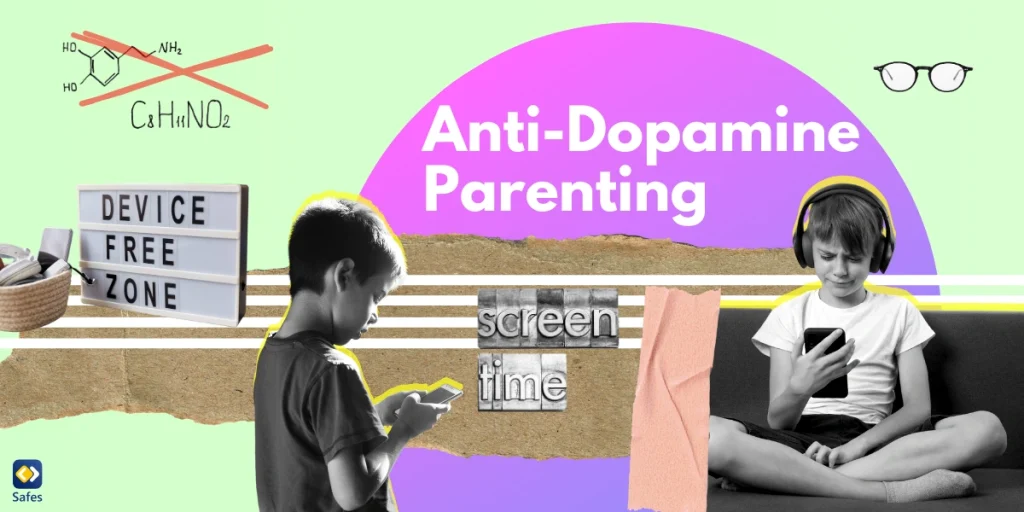As parents, we frequently worry about our children’s screen time. However, knowing how technology influences young minds is crucial. This article discusses the impacts of dopamine on children, bad dopamine habits and screen time, best ways to get dopamine, and anti-dopamine parenting strategies.
Download and Start Your Free Trial of the Safes Parental Control App
This is where the concept of anti-dopamine parenting comes into play. By managing and moderating activities that overstimulate dopamine production, such as excessive screen time, parents can help create a more balanced environment for their children, potentially reducing the risk of developing such mental health issues and promoting overall well-being.
Dopamine and Its Impact on Children
Dopamine, a neurotransmitter, plays a significant role in the brain’s reward system. It is released when we engage in enjoyable activities, rewarding such behaviors. In children, Dopamine release occurs during various activities, such as playing, socializing, and learning. This promotes the formation of neural connections associated with memory, focus, and critical thinking. However, excessive dopamine release can result in adverse effects such as addiction and impulsivity. When children are constantly exposed to high dopamine-inducing activities, such as extended screen time or video game play, their brains may adapt by decreasing dopamine production or the amount of dopamine receptors. This can progress to tolerance, where the child needs increasingly higher levels of stimulation to achieve the same satisfaction, leading to a cycle of addiction.
Consider the example of a child who spends hours each day playing video games. Over time, their brain’s reward system grows desensitized to the regular dopamine release, encouraging them to play even more to maintain the same degree of happiness. This can lead to video game addiction, which has a detrimental impact on the child’s emotions, academic performance, and general well-being. For example, when a child enjoys playing a sport like soccer, dopamine release helps create positive associations with physical activity, promoting the desire to continue playing.
What Is Anti-Dopamine Parenting?
Anti-dopamine parenting is a method for helping children control their dopamine levels by limiting their reliance on quick gratification activities, particularly those involving excessive screen time. This strategy entails establishing clear boundaries for the use of digital devices, encouraging delayed gratification, and fostering a healthy lifestyle that includes physical activity, face-to-face interactions, and participation in activities that demand sustained effort. By limiting the constant stimulation provided by screens, parents aim to help their children develop better habits and a more balanced relationship with technology.
So, “What is anti-dopamine parenting” in practice? It includes creating tech-free zones in the home, such as removing digital gadgets from bedrooms and dining areas and setting screen time limits. Parents may also play an important role by modeling healthy behavior, participating in non-screen activities with their children, and encouraging open discussions about the value of digital balance. Furthermore, parents can promote activities that involve patience and effort, like reading, puzzles, and physical play. This allows children to experience satisfaction from more meaningful and long-term benefits rather than immediate digital gratification.
The term “anti-dopamine parenting” closely aligns with the principles discussed by Dr. Anna Lembke, a prominent psychiatrist and author, in her book “Dopamine Nation.” Dr. Lembke explores the impact of dopamine on behaviors and addictions, including the effects of digital and screen time addiction. Dr. Lembke’s work has significantly contributed to the understanding of dopamine’s role in modern parenting challenges and strategies to relieve its negative effects.
Dopamine imbalance has been related to various mental health disorders, including depression, schizophrenia, and ADHD. Many medications used to treat these conditions work by altering dopamine levels in the brain.
Bad Dopamine Habits
Dopamine is commonly referred to as the “feel-good” neurotransmitter since it is associated with pleasure and reward. When we participate in rewarding activities, dopamine is produced, reinforcing the action and motivating us to repeat it. This process is necessary for learning and motivation, but it may also contribute to the development of bad habits when dopamine-inducing activities become excessive or addictive. This can cause delaying important tasks in favor of instant gratification activities and leads to stress and decreased performance.
Common bad dopamine habits include:
- Social Media Addiction: Constantly checking social media platforms for likes, comments, and messages can create an unhealthy dependency on instant feedback and validation.
- Binge-Watching TV Shows: Watching multiple episodes of a TV series in one sitting can lead to prolonged periods of inactivity and disrupt sleep patterns.
- Compulsive Video Gaming: Dopamine and video games are closely linked, since games are designed to deliver quick reward and a sense of accomplishment, which leads to addictive behavior.
- Frequent Online Shopping: Constantly buying things online for the thrill of receiving new items can lead to financial problems and clutter.
- Endless Scrolling: Mindlessly scrolling through feeds on social media, news websites, or other apps can waste time and reduce productivity.
- Gambling: Engaging in gambling, whether online or in-person, can lead to addiction and significant financial losses.
- Chasing Novelty: Continuously seeking out new experiences or activities for the dopamine rush can prevent one from appreciating and sticking with long-term goals.
- Substance Abuse: Using drugs or alcohol to achieve a high can lead to addiction and severe physical and mental health issues.
- Engaging in Risky Behaviors: Pursuing dangerous activities for the thrill can result in physical harm and long-term consequences.
- Compulsive Checking of Notifications: The relationship between dopamine and cellphones is evident in how frequent notifications and social media updates can create addictive behaviors. Constantly checking for new messages, emails, or app notifications can create anxiety and disrupt focus.
Most of the concepts mentioned above fall under the general topic of dopamine and screen time. These issues can be managed by parents through anti-dopamine parenting strategies. In this the next section, we will delve into and explain the connection between screen time and dopamine, which is one of the most crucial issues in the digital age, particularly for children and teenagers.

Screen Time and Its Effects on Dopamine
Screen time and dopamine are inextricably linked, as the constant interaction with digital gadgets can have a significant impact on our brain chemistry and general health. While screen time might stimulate dopamine release, excessive use can have a negative impact on the brain’s reward system.
Continuous exposure to high dopamine-inducing activities, such as prolonged screen time, can reduce dopamine production or the number of dopamine receptors. This adaptation can evolve to tolerance, which requires greater amounts of stimulus to reach the same degree of satisfaction.
Overeating Junk Food
Excessive screen time often coincides with a sedentary lifestyle and the development of unhealthy eating habits, such as overeating junk food. These behaviors, also fueled by dopamine release, can contribute to poor health and weight gain.
Reduced Attention Span
Attention span, especially on social media, affects children’s minds in a negative way. This is another concern related to dopamine and screen time. Constant digital stimulation trains the brain to expect instant gratification, making it difficult to focus on tasks that need prolonged attention. This can impact performance in academic and professional contexts.
Social Isolation
Screen usage and dopamine dynamics result in increased social isolation. Online interactions often replace face-to-face connections, which are more meaningful. The brain’s preference for quick, gratifying social conversations online can lead to a preference for virtual rather than real-life engagements.
Poor Sleep Habits
Poor sleep patterns are also caused by the interaction between dopamine and screen time. The blue light from screens affects melatonin production, while stimulating content keeps the brain alert. This combination can result in insomnia and other sleep issues, exacerbating the effects of excessive screen time.
Anti-Dopamine Parenting Methods for Screen Time Management
Social media, video games, and online videos provide immediate rewards, reinforcing dopamine release. This can make real-life activities seem less appealing and lead to neglect of personal relationships, health, and productivity. As a result, people may find it difficult to disconnect from their devices, leading to excessive screen time and dopamine phone addiction.
By implementing these anti-dopamine parenting techniques, parents can help their children in developing healthier connections with technology, promoting balanced dopamine levels and fostering improved long-term wellbeing:
Setting Screen Time Limits
One of the key principles of anti-dopamine parenting is to set clear boundaries for screen time usage. This involves:
Creating Schedules: Establish specified periods for device use, such as permitting screen time only when homework or chores are finished.
Using Parental Control Apps: Utilize built-in features on your kid’s smartphone to limit access to specific applications and limit usage time.
Encourage Breaks: Make sure that children take regular pauses from their devices to participate in physical activity or other offline hobbies.
Promoting Delayed Gratification
Encouraging activities that require patience and consistent effort helps to balance the brain’s reward system. Several techniques include:
Reading: Encourage reading books, which demand longer attention spans and offer incremental rewards.
Puzzles and Games: Provide puzzles, board games, and other activities that involve problem-solving and critical thinking.
Hobbies and Crafts: Encourage hobbies like sketching, painting, and model building, which provide satisfaction through hard work and creativity.
Encouraging Physical Activity
Physical activity is necessary for normal dopamine levels and general wellness. Here are some ways to include this into your regular routine:
Outdoor Play: Encourage your children to spend time outside, whether they are playing sports, riding bikes, or simply enjoying nature.
Family Activities: Plan frequent family activities such as hiking, swimming, or playing catch in the park.
Exercise Routines: Introduce age-appropriate exercise routines or classes, such as dance, gymnastics, or martial arts.

Establishing Tech-Free Zones
Creating locations in the home where screens are not allowed can help lessen the temptation to use devices continuously:
Bedrooms: To encourage better sleep hygiene and relaxation, keep technology out of the bedroom.
Dining Areas: Encourage family dinners without screens to improve conversation and bonding.
Study Areas: Set aside specific areas for schoolwork and studying that are free from digital distractions.
Modeling Healthy Behavior
Children frequently emulate their parents’ actions. Demonstrating good screen habits can inspire children to follow suit:
Limit Your Own Screen Time: Be conscious of how you use your devices, especially during family time.
Participate in Shared Activities: Play non-screen hobbies together, such as board games, cooking, or gardening.
Discuss Digital Balance: Have frank discussions about the importance of balancing screen time with other activities and the reasons for setting limitations.
Promoting Social Interaction
Promote face-to-face interactions to help children develop social skills and reduce reliance on digital communication:
Playdates and Group Activities: Schedule kids playdates or group activities with peers to promote social interaction.
Community Involvement: Encourage participation in community events, clubs, and sports teams.
Family Time: Prioritize quality family time via activities like game nights, outings and trips to strengthen relationships.
Providing Alternative Rewards
Providing alternative sources of reward and satisfaction can help minimize dependency on digital dopamine hits:
Reward Systems: Create incentive systems for accomplishing activities or demonstrating excellent conduct that do not require screen time, such as earning points for a special excursion or a new book.
Positive Reinforcement: Use praise and positive reinforcement to acknowledge efforts and accomplishments in offline activities.
Educational Content and Mindful Usage
When screen time is required, make it useful and educational:
Educational Applications and Programs: Choose applications and programs that encourage learning and development especially for elementary schoolers.
Co-Watching and Co-Playing: Participate with children during screen time to create a shared, interactive experience, discussing the content and fostering critical thinking.
Parenting Tips for Nurturing Your Child’s Dopamine Levels
Understanding your child’s dopamine balance is crucial for their motivation and overall well-being. Here are some strategies tailored for children to naturally boost dopamine levels:
Encourage Physical Activity
Engage your child in regular physical activities like outdoor games, cycling, or dancing to increase dopamine levels.
Offer Healthy Diet
Boost your child’s dopamine levels with a diet rich in protein from almonds, bananas, poultry, and avocados, essential for dopamine production. Encourage antioxidant-rich fruits and vegetables like berries and leafy greens to protect dopamine-producing neurons. Consider probiotic-rich foods such as yogurt, kefir, and kimchi to enhance dopamine production, supporting your child’s neurological health and well-being.
Prioritize Sleep Hygiene
Help your child sleep better by sticking to a consistent bedtime routine and creating a peaceful sleep environment, improving sleep quality and dopamine regulation. Ensure they get 7-9 hours of sleep nightly for optimal brain function and dopamine production, maintaining a regular sleep schedule every day.
Engage in Mindfulness Activities
Introduce your child to meditation for stress reduction and well-being, possibly boosting dopamine levels. Support mindfulness through activities like deep breathing, yoga, or tai chi, promoting emotional health. These practices can help manage stress and enhance well-being.
Empower Your Child’s Success
Guide them to set small, achievable goals, offering dopamine boosts with each success. Celebrate their victories to nurture positive behavior and motivation. These simple strategies empower your child’s development and drive.
Nurture Their Passions
Encourage your child to explore hobbies like painting, music, writing, or handicrafts, stimulating dopamine production. Engaging in new activities or learning fresh skills can be rewarding, offering a dopamine boost and fostering their growth and satisfaction.
Boost Their Mood and Creativity
Encourage your child to listen to their favorite tunes to elevate dopamine levels, enhancing mood and motivation. Additionally, actively playing a musical instrument fosters dopamine production through creative expression and skill refinement. These activities ignite their passion and drive, promoting overall well-being.
Nurture Meaningful Connections
Spend quality time with your child, engaging in meaningful conversations and enjoyable activities, to boost dopamine levels and strengthen your bond. Encourage them to build supportive social networks, fostering emotional well-being through strong relationships. These connections provide a sense of belonging and support, enhancing your child’s overall happiness and fulfillment.
Embrace Sunlight
Encourage regular exposure to natural light to regulate dopamine production. Ensure sufficient vitamin D levels, essential for dopamine synthesis, through sunlight exposure or supplements under healthcare guidance.
Mindful Rewards
Encourage balanced indulgence by savoring small, meaningful treats or leisure activities for a healthy dopamine boost. Remind your child to avoid overindulgence in activities like excessive screen time or junk food consumption, which can lead to unhealthy dopamine spikes.
Meet Safes: Balancing Dopamine Levels and Screen Time Management with Safes Parental Control App
Discover Safes – the ultimate parental control app designed to help you create a safe and nurturing digital environment for your child. With Safes, you can protect your child from harmful content, inspire positive device utilization, and set boundaries for screen time while promoting healthy dopamine regulation.
Safes is a versatile and feature-rich parental control app that offers:
- Internet Filtering: Protect your child from harmful content by applying internet filtering and blocking inappropriate websites and materials.
- Screen Time Management: Inspire positive device utilization by setting screen time boundaries and tracking the use of apps. This helps to manage dopamine levels by avoiding excessive exposure to dopamine-triggering digital activities.
- Real-time Location and Safety Zones: Customize location tracking to ensure your child’s safety, giving you peace of mind while they explore the digital world.
Safes is the ideal solution for parents looking to manage their child’s screen time and promote healthy dopamine regulation. With Safes, you’ll have the tools necessary to foster a safe, nurturing, and supportive digital environment where your child can thrive. Compatible with both Android and iOS devices, as well as MacBook parental control and other devices, Safes offers the ultimate guide for modern parents navigating the fast-paced digital landscape.
Don’t wait to experience the advantages of the Safes parental control app. Download the app today and start your free trial to begin your journey toward effective screen time management and healthy dopamine levels for your child.
Conclusion
As parents, it is essential to recognize the impact of dopamine on children’s development and adopt anti-dopamine parenting strategies to protect them in a tech-driven world. By fostering a balanced approach to technology, parents can help children build resilience, self-regulation, and a strong foundation for future success.
Through understanding dopamine, its effects on children’s brains, and implementing anti-dopamine parenting techniques, we can create a healthier, more balanced environment for children to grow and thrive in the digital age.
Your Child’s Online Safety Starts Here
Every parent today needs a solution to manage screen time and keep their child safe online.
Without the right tools, digital risks and excessive screen time can impact children's well-being. Safes helps parents set healthy boundaries, monitor activity, and protect kids from online dangers—all with an easy-to-use app.
Take control of your child’s digital world. Learn more about Safes or download the app to start your free trial today!




